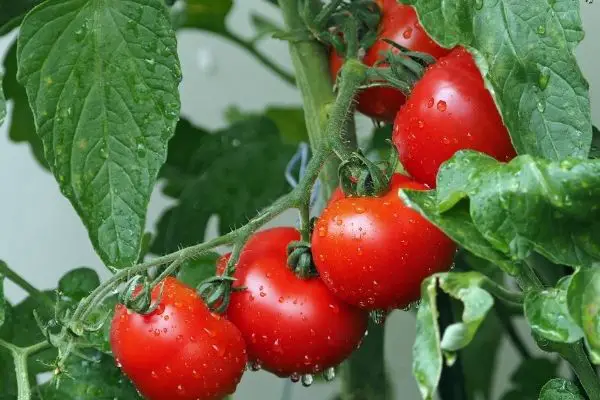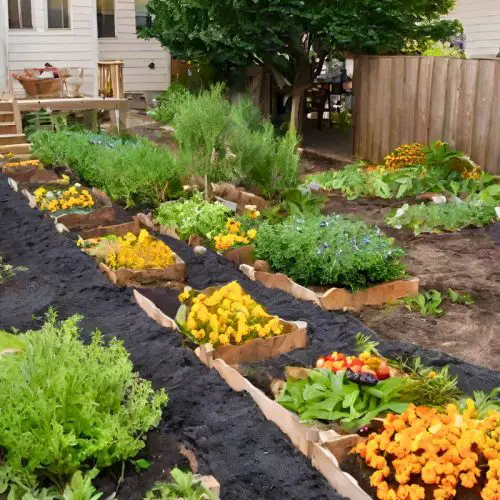Container gardening is a great way to enjoy fresh produce right from your own backyard. There are so many varieties to choose from and homegrown lettuce is tastier than any store-bought lettuce you’ve ever had. In this step-by-step guide, you will learn how to grow lettuce in containers using organic methods. Let’s get started!

How to Grow Lettuce in Containers
For years, I was unsuccessful in growing lettuce in the Deep South. Then I decided to give growing lettuce in containers a shot. For the past three years, we’ve had more lettuce than I ever anticipated. Weeding, disease control, and harvesting seed are all easier when you grow lettuce in containers.
Different Types of Lettuce
There are records of lettuce cultivation as far back as 500 B.C. It is said Columbus brought to the Americas. While there are many lettuce varieties to choose from, there are only five basic types.
- Butterhead – Forms a loose, leafy head. The delicate, delectable flavor is exquisite.
- Some varieties are what we call “Cut and Come Again” types. This means you don’t pull them up like head or romaine lettuce. You simply pluck or cut the leaves off you want to eat and the lettuce will regrow leaves to replace what you took.
- Celtuce – Like a celery plant, it grows without many leaves. It’s grown for its stems rather than its leaves.
- Crisphead – Iceberg lettuce is the most well-known variety of this kind. These make large, firm heads.
- They lack color, vitamins, and minerals, and have a flat flavor.
- They’re excellent for industrial manufacturing but are difficult to grow in a home garden.
- They require twice as long to mature as leaf lettuce varieties. Head lettuces take 80 to 95 days to mature.
- Looseleaf – These are the most popular type. A few varieties can even stand up to the early part of our hot summers without bolting (maturing right away and producing seeds) right away.
- My favorite of these is Oakleaf and Deer Tongue. Yep, they got their names from the way they look.
- Looseleaf lettuce has a more robust flavor and may require some getting used to. Most varieties mature early at 40 to 45 days.
- Most of these are also “Cut and Come Again”. These are the most productive and versatile in my opinion.
- Romaine – Unlike crisphead or looseleaf types, it forms looser leaves surrounding a tight middle.
- It can withstand some heat, but not as much as leaf lettuce.
- It takes 70 to 85 days to mature.

When to Plant Lettuce
Lettuce is a cool-weather crop that is not frost-hardy. Although some varieties can withstand some heat without bolting, most prefer cooler temperatures. Your growing zone will determine if you can grow it in the spring, winter, or in spring and winter.
- For spring planting, sow as soon as the soil is workable and the risk of hard frost has passed.
- For winter planting, sow when the soil temperature is below 75 degrees F. Lettuce does not germinate well in soil warmer than 75 degrees F.
- Be sure that your plants are shaded from long exposure to the midday sun in both spring and winter.
The Container and Soil
The size of your container and the quantity of lettuce you wish to produce are the first things to consider. In a 10-12 inch pot, you may grow a few different kinds.
Keep in mind that lettuce is mostly water, so make sure your soil is always moist without being soggy. Lettuce can’t survive wet roots, so be sure your container has a good drainage system.
Successfully growing lettuce containers depends on the size of the container, the type and health of the soil, and moisture.
Whatever soil you use, make sure it’s loose and well-worked. Sand, composted soil, and dirt from the chicken yard make up our 2:1:2 mixture.

How to Plant Lettuce in a Container
There are two ways to get your lettuce started. I’ve used both and had good results with both methods. The two options are planting seeds for transplanting or direct sowing. I prefer the direct sowing method.
Planting Seeds for Transplanting Method
- Prepare your seed trays with soil and sow the seeds in them.
- Lightly cover with no more than 1/4 inch of soil.
- I like to scatter seeds across the seed tray and lightly brush dirt over them.
- Place the tray where it can get plenty of sunlight but avoid direct exposure to the sun to avoid drying the soil.
- Some seed trays come with lids or you can cover the tray with painter’s plastic.
- This keeps the rain off them, gives them a greenhouse effect, and keeps the moisture level just right. All this while letting in the light!
- Keep the seedbed moistened until they sprout. Then water as needed.
- When they have developed two true leaves, transplant them to their containers.
- Place transplants in your container by making a 1-2 inch hole. Place your transplant in the hole, replace the soil, and pack it gently.
- Be careful not to crush the roots.
- Water them thoroughly.
Direct Sowing Method
- To direct sow your seed, place the seed 1/4 to 1/2 inch deep in moistened soil and lightly cover.
- The seeds packet will say “sow your seeds 4 to 6 inches apart” but lettuce seeds are teeny-tiny.
- You can purchase a tool to help distribute them easier or an easier way is to thin the seedlings when they start growing.
- The thinnings are delicious snacks and sandwich toppers.
- Remember to not let the seedbed dry out, keep it evenly moist

Tips for Growing Lettuce in Containers
Keep in mind that looseleaf and romaine lettuce varieties require less growing area than head or stalk lettuce types.
The general rule is to place transplants 4-6 inches apart. Don’t worry about being meticulous in the spacing; just make sure each one has the needed space. A one-gallon container can accommodate 2-3 plants depending on the requirements of the variety.
Leave room around the edge of the container for fertilization, watering, and mulching. Lettuce is the only crop I don’t mulch but I know some people do so. When growing lettuce in a container, mulching does assist in keeping the soil evenly moist.
- Make sure your plants have adequate space.
- Maintain adequate moisture, but not wet.
- Make sure the container has excellent drainage.
- Fertilize only if you believe your soil isn’t supplying what your plants need.
- You should not fertilize your lettuce until it is at least 8 to 10 weeks old.
- Root burn is a problem if you fertilize before this because of its shallow roots.
- Do not disturb the roots of neighboring plants when thinning.
- Practice succession planting to keep your harvest going. This means that you plant another container(s) at two-week intervals until you have all you want.
- Always harvest lettuce in the early morning. Direct exposure to the sun stresses plants and causes the tender leaves to wilt. Cutting plants when they are in distress will damage them.

To Store Fresh Lettuce
It is best eaten fresh from the garden but if want to keep it for later:
- Wash it in cool water.
- Adding a little apple cider vinegar to the water will help preserve the crispness of the leaves.
- Remove any damaged or discolored portion you want to remove
- Place it on a clean, dry dishtowel in a single layer.
- Allow to air dry.
- When it is mostly dry, gently pat any remaining water from the leaves and wrap it in a damp dishtowel or paper towel and seal it in a plastic bag.
- Unlike store-bought lettuce, fresh lettuce treated like this will be good for two weeks or more.
How to Avoid Bolting
Lettuce is said to “bolt” when it suddenly matures and produces seed rapidly. This happens with the approach of summer, increased temperature, and longer days.
When lettuce bolts it develops a bitter taste and you won’t enjoy eating it. Some types of lettuce are more resistant to bolting than others. The seed packet or catalog will say, “slow bolting” or “bolt resistant”.
You can’t prevent bolting, but you can extend the growing season.
- Plant as early in the spring as possible, whether indoors or outdoors.
- Use succession planting throughout the fall and winter to lengthen the season.
- Protect lettuce from direct sunlight from mid-morning to late evening.

Saving Lettuce Seeds
Lettuce does not cross-pollinate with its neighbors because of the self-fertilizing properties it has. However, there is a chance of crossing with wild types of lettuce, such as dandelions, just so you know.
- Allow your plants to bolt. A straight stalk will shoot up and produce beautiful yellow flowers. These flowers will mature into seeds.
- Once the flowers have produced seeds, you can place a paper bag over the stalk and shake it well.
- This will help you gather the mature seeds.
- The immature seeds will stay on the plant until they’re ready.
- When you’ve collected enough seeds, you may either stop collecting them or pull the plants.
- NOTE: Any mature seeds that fall into your container will probably produce volunteer plants next season.
An alternative method
- Let half of the seeds ripen and then pull the plant up by the roots.
- Place the plant onto a drop cloth or upside down in a bucket.
- This allows the developed seeds to fall where you can easily gather them and the immature seeds should continue to mature and fall off as well.
- Use a 1/8-inch screen to separate the seeds from plant debris.
Lettuce seeds will usually remain viable for three years if kept in a cool, dry location.

Wrap Up
I love growing lettuce in containers. It frees up precious garden real estate for more tomato varieties! Plus, growing it this way makes it easier to keep weeds out, make sure the lettuce has the right moisture level and keeps it closer to the kitchen for harvesting.
Reminders:
- Make sure your plants have adequate space.
- Maintain adequate moisture, but not wet.
- Make sure the container has excellent drainage.
- Fertilize only if you believe your soil isn’t supplying what your plants need.
- You should not fertilize your lettuce until it is at least 8 to 10 weeks old.
- Root burn is a problem if you fertilize before this because of its shallow roots.
- Do not disturb the roots of neighboring plants when thinning.
- Practice succession planting to keep your harvest going. This means that you plant another container(s) at two-week intervals until you have all you want.
- Always harvest lettuce in the early morning. Direct exposure to the sun stresses plants and causes the tender leaves to wilt. Cutting plants when they are in distress will damage them.
Knowing how to grow lettuce in containers is an excellent method for anybody who doesn’t have a lot of space in their backyard to grow a variety of types of lettuce.





Thank you so much Rhonda for sharing the simple ways to grow lettuce as well as all the other methods. I grow lettuce but the extra info was very helpful.
Iris
Iris, Thank you for letting us know you found the articles helpful. We’re so glad to hear it!